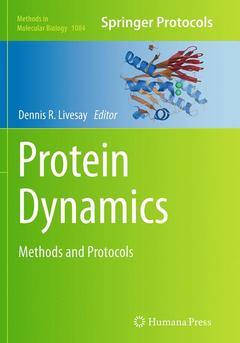Description
Protein Dynamics, 2014
Methods and Protocols
Methods in Molecular Biology Series, Vol. 1084
Coordinator: Livesay Dennis R.
Language: English
Subject for Protein Dynamics:
Publication date: 08-2016
Support: Print on demand
Publication date: 09-2013
285 p. · 17.8x25.4 cm · Hardback
Description
/li>Contents
/li>Comment
/li>
In Protein Dynamics: Methods and Protocols, expert researchers in the field detail both experimental and computational methods to interrogate molecular level fluctuations. Chapters detail best-practice recipes covering both experimental and computational techniques, reflecting modern protein research. Written in the highly successful Methods in Molecular Biology? series format, chapters include introductions to their respective topics, lists of the necessary materials and reagents, step-by-step, readily reproducible laboratory protocols, and key tips on troubleshooting and avoiding known pitfalls.
Authoritative and practical, Protein Dynamics: Methods and Protocols describes the most common and powerful methods used to characterize protein dynamics.
Monitoring Side-Chain Dynamics of Proteins Using 2H Relaxation.- CPMG Relaxation Dispersion.- Confocal Single-Molecule FRET for Protein Conformational Dynamics.- Protein Structural Dynamics Revealed by Site-directed Spin Labeling and Multifrequency EPR.- Probing Backbone Dynamics With Hydrogen/Deuterium Exchange Mass Spectrometry.- Carbon-Deuterium Bonds as Non-perturbative Infrared Probes of Protein Dynamics, Electrostatics, Heterogeneity, and Folding.- Balancing Bond, Nonbond and Gō-like Terms in Coarse Grain Simulations of Conformational Dynamics.- Tutorial on Building Markov State Models with MSMBuilder and Coarse-graining them with BACE.- Analysis of Protein Conformational Transitions Using Elastic Network Model.- Geometric Simulation of Flexible Motion in Proteins.- Principal Component Analysis: A Method for Determining the Essential Dynamics of Proteins.- A Case Study Comparing Quantitative Stability/Flexibility Relationships Across Five Metallo-β-Lactamases Highlighting Differences within NDM-1.- Towards Comprehensive Analysis of Protein Family Quantitative Stability/Flexibility Relationships using Homology Models.- Using the COREX/BEST Server to Model the Native State Ensemble.- Morphing Methods to Visualize Coarse-grained Protein Dynamics.




